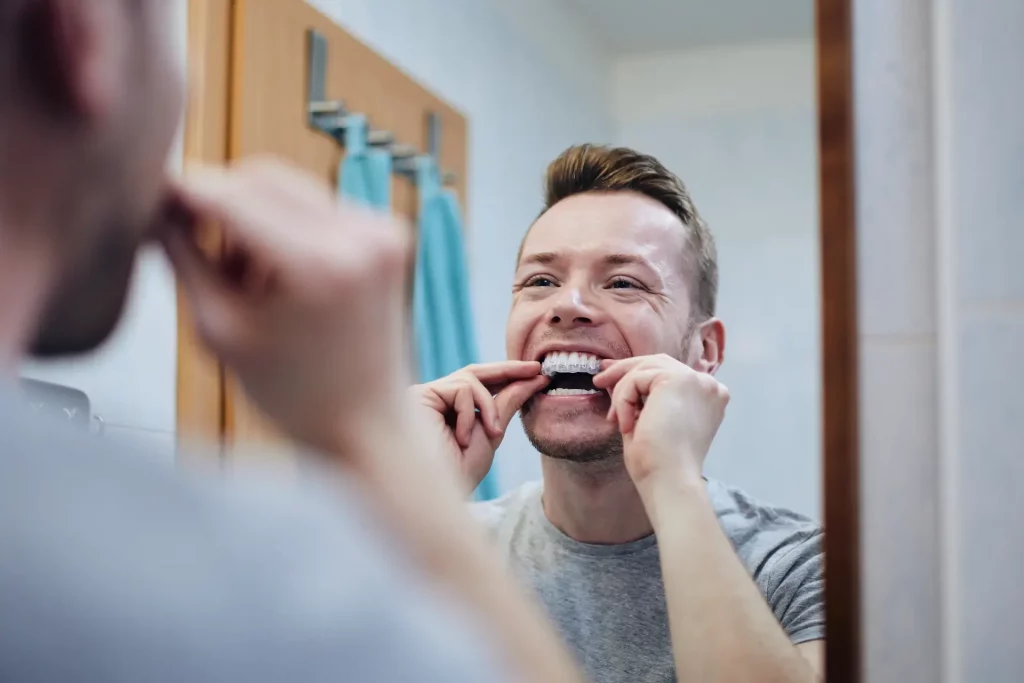Interested in straightening your teeth without traditional braces? Invisalign Express may be the right choice for you! This orthodontic treatment uses clear aligners to address minor misalignments and small gaps in your teeth. It’s an effective alternative that requires minimal lifestyle disruption and no wires or tightenings, making it ideal for those with busy lifestyles. Read on to learn more about Invisalign Express, including who is a good candidate, expected results, cost, treatment process, pros and cons, and aftercare.

Invisalign Express is a shortened treatment option for minor teeth straightening. It is designed for individuals who have mild orthodontic issues and want a quicker solution than traditional braces. This treatment uses the same clear aligner technology as the standard Invisalign treatment but is specifically tailored for minor dental adjustments.
With Invisalign Express, patients wear a series of removable aligners that gradually move their teeth into the desired position. These aligners are custom-made to fit snugly over the teeth, making them almost invisible. The treatment duration for Invisalign Express is typically shorter than the standard Invisalign treatment, ranging from 3 to 6 months.
Although Invisalign Express is a shorter treatment option, it still provides effective results for patients with minor orthodontic concerns, such as slight crowding or spacing issues. It is crucial to consult with an orthodontist to determine if Invisalign Express is the right treatment choice for your specific dental needs.
Invisalign Express and Invisalign Lite are variations of the Invisalign treatment designed for different levels of orthodontic issues. Invisalign Express is intended for minor concerns like slight crowding, with a shorter treatment time of 3 to 6 months and a reduced number of aligners. In contrast, Invisalign Lite covers a broader range of issues that are more complex than Express but less extensive than full Invisalign treatments. It involves a longer treatment period with an average of 6 to 9 months and requires more aligners. The choice between the two depends on the severity of misalignment, with Express suited for minimal issues and Lite suitable for moderate cases. Professional assessment by an orthodontist is essential to determine the best-fit treatment for individual needs.
Invisalign® Express is a treatment option designed for individuals with minor orthodontic issues or if you have had prior treatments such as braces or Invisalign and your teeth are out of alignment again. Good candidates for Invisalign® Express typically have the following characteristics:
Ultimately, the best way to determine if you are a good candidate for Invisalign® Express is to consult a dentist. They will evaluate your specific orthodontic needs and recommend the most appropriate treatment option for you.
Embarking on an Invisalign Express treatment journey comes with certain expectations and considerations. The treatment duration will depend on the complexity of your orthodontic needs and your adherence to the guidelines provided by your orthodontist or dentist. During your initial consultation, a personalized treatment plan will be outlined to your specific case, highlighting the cost and number of aligners needed.
The cost will vary based on factors such as the dental office you choose, the coverage provided by your dental insurance for orthodontic care, the nature of your dental misalignment, and the number of aligners required to achieve the desired results. Whether you have dental insurance coverage or not, discussing the financial aspect with your provider during the consultation is recommended to understand the investment involved in achieving your desired smile transformation.
The treatment process begins with a digital scan of your teeth, which is utilized to formulate a personalized aligner treatment plan. Once we have crafted the customized treatment plan, we will transmit your digital scans for production, and the finalized aligners are sent to the office. Before putting on your aligners, you’ll also have small attachments bonded to your teeth.
You’ll wear the aligners 20-22 hours a day, and change them every 1-2 weeks as instructed by your dentist or orthodontist. You’ll also visit the dentist for regular checkups to monitor your progress. Once you have completed wearing all the aligners in your series, your dentist will evaluate your teeth to ensure that the desired results have been achieved. If needed, additional refinement aligners may be provided to fine-tune the alignment.
Upon completing the treatment, your dentist will furnish you with a set of retainers designed to maintain the new alignment of your teeth. It’s important to note that the exact treatment process may vary depending on individual cases and the specific recommendations of your Invisalign provider.
Invisalign Express offers a faster and more cost-effective alternative to the standard Invisalign treatment, making it an ideal choice for individuals with minor adjustments. Nevertheless, similar to any form of treatment, Invisalign Express does have its drawbacks. Therefore, it is crucial to carefully assess the advantages and disadvantages before determining if it aligns with your needs. Ultimately, this treatment option can help you achieve a beautiful smile within a relatively short timeframe if you have minor orthodontic issues.
Pros:
1. Shorter treatment time: Invisalign Express is designed for minor orthodontic issues, so the treatment time is usually shorter than traditional braces or standard Invisaligntreatment.
2. Less noticeable: Invisalign aligners are clear and virtually invisible, making them a more discreet option for those concerned about the appearance of traditional braces.
3. Removable aligners: Invisalign aligners can be easily removed for eating, brushing, and flossing, allowing for better oral hygiene than traditional braces.
4. Comfortable: Invisalign aligners are made of smooth plastic, which means they are generally more comfortable to wear than traditional braces, as they don’t have any sharp or protruding wires or brackets.
Cons:
1. Limited treatment options: Invisalign Express is suitable for minor orthodontic issues only, so it may not be the most appropriate option for individuals with more complex dental problems.
2. Less control over tooth movement: Invisalign Express may not have the same level of precision and control over tooth movement as traditional braces, which can result in less predictable outcomes in some cases.
3. Cost: While Invisalign Express is generally less expensive than standard Invisalign treatment, it can still be more costly than traditional braces, depending on the specific case and treatment needs.

Invisalign Express aftercare is a crucial phase to ensure that your newly aligned smile remains as intended. Following the active treatment period, you will transition into wearing retainers, which are custom-designed to maintain the corrected positions of your teeth.
Depending on your dentist recommendation, these retainers may be removable or fixed. Consistency in wearing your retainers as directed is essential to prevent any undesired shifts in tooth alignment. Regular follow-up appointments with your dentist will allow them to monitor the stability of your results and make any necessary adjustments to your aftercare plan, and visiting your dentist for regular checkups and cleanings are recommended. By diligently adhering to the aftercare routine and maintaining good oral hygiene practices, you can maintain your perfect smile.
The biggest difference between Invisalign Express and traditional Invisalign treatment lies in the complexity of teeth straightening and treatment time. Invisalign Express uses fewer aligners and is usually used for minor cosmetic adjustments, whereas a traditional Invisalign treatment requires 20 to 30 aligners and are capable of tackling more intricate orthodontic concerns, such as crooked and misaligned teeth.
Invisalign Express aligners work in the same way as traditional Invisalign. They apply steady, controlled force to gradually move teeth into alignment. However, treatment with Invisalign Express requires fewer aligner sets as it’s designed for less complex cases.
Invisalign Express aligners should be worn for about 20-22 hours per day, and are switched out for new ones every two weeks. This schedule ensures the continuous and controlled teeth movement required for successful treatment.
The treatment time for Invisalign Express is typically much shorter than traditional Invisalign treatments. It usually takes about 3-6 months, but can vary depending on how regularly the aligners are worn and the complexity of the dental case.
During an Invisalign Express consultation, the orthodontist assesses the patient’s teeth and oral health to determine if they are a suitable candidate. This typically involves dental x-rays and a digital scan of your teeth. The consultation is an opportunity to discuss the treatment plan and the associated costs.
Invisalign Express is a fast and less intrusive alternative to traditional braces. Unlike braces, the aligners are nearly invisible and can be removed for eating and cleaning. However, they are best suited for minor dental corrections and not ideal for complex orthodontic cases that other treatments may address

Opting for Invisalign Express presents a fantastic solution to aligning teeth without the complexities of traditional braces. It offers a swift and customizable approach that aligns well with your lifestyle. If you’re in search of an impactful orthodontic treatment that doesn’t greatly interrupt your routine, considering Invisalign Express is definitely a worthwhile choice!
At Sloan Creek Dental, we offer a a custom treatment plan that fits your orthodontic needs. If you’re in the Fairview Allen area and want straight teeth, contact us at our Fairview, TX dental office to schedule your dental appointment at 972-468-1440.
We firmly believe that the internet should be available and accessible to anyone, and are committed to providing a website that is accessible to the widest possible audience, regardless of circumstance and ability.
To fulfill this, we aim to adhere as strictly as possible to the World Wide Web Consortium’s (W3C) Web Content Accessibility Guidelines 2.1 (WCAG 2.1) at the AA level. These guidelines explain how to make web content accessible to people with a wide array of disabilities. Complying with those guidelines helps us ensure that the website is accessible to all people: blind people, people with motor impairments, visual impairment, cognitive disabilities, and more.
This website utilizes various technologies that are meant to make it as accessible as possible at all times. We utilize an accessibility interface that allows persons with specific disabilities to adjust the website’s UI (user interface) and design it to their personal needs.
Additionally, the website utilizes an AI-based application that runs in the background and optimizes its accessibility level constantly. This application remediates the website’s HTML, adapts Its functionality and behavior for screen-readers used by the blind users, and for keyboard functions used by individuals with motor impairments.
If you’ve found a malfunction or have ideas for improvement, we’ll be happy to hear from you. You can reach out to the website’s operators by using the following email
Our website implements the ARIA attributes (Accessible Rich Internet Applications) technique, alongside various different behavioral changes, to ensure blind users visiting with screen-readers are able to read, comprehend, and enjoy the website’s functions. As soon as a user with a screen-reader enters your site, they immediately receive a prompt to enter the Screen-Reader Profile so they can browse and operate your site effectively. Here’s how our website covers some of the most important screen-reader requirements, alongside console screenshots of code examples:
Screen-reader optimization: we run a background process that learns the website’s components from top to bottom, to ensure ongoing compliance even when updating the website. In this process, we provide screen-readers with meaningful data using the ARIA set of attributes. For example, we provide accurate form labels; descriptions for actionable icons (social media icons, search icons, cart icons, etc.); validation guidance for form inputs; element roles such as buttons, menus, modal dialogues (popups), and others. Additionally, the background process scans all of the website’s images and provides an accurate and meaningful image-object-recognition-based description as an ALT (alternate text) tag for images that are not described. It will also extract texts that are embedded within the image, using an OCR (optical character recognition) technology. To turn on screen-reader adjustments at any time, users need only to press the Alt+1 keyboard combination. Screen-reader users also get automatic announcements to turn the Screen-reader mode on as soon as they enter the website.
These adjustments are compatible with all popular screen readers, including JAWS and NVDA.
Keyboard navigation optimization: The background process also adjusts the website’s HTML, and adds various behaviors using JavaScript code to make the website operable by the keyboard. This includes the ability to navigate the website using the Tab and Shift+Tab keys, operate dropdowns with the arrow keys, close them with Esc, trigger buttons and links using the Enter key, navigate between radio and checkbox elements using the arrow keys, and fill them in with the Spacebar or Enter key.Additionally, keyboard users will find quick-navigation and content-skip menus, available at any time by clicking Alt+1, or as the first elements of the site while navigating with the keyboard. The background process also handles triggered popups by moving the keyboard focus towards them as soon as they appear, and not allow the focus drift outside of it.
Users can also use shortcuts such as “M” (menus), “H” (headings), “F” (forms), “B” (buttons), and “G” (graphics) to jump to specific elements.
We aim to support the widest array of browsers and assistive technologies as possible, so our users can choose the best fitting tools for them, with as few limitations as possible. Therefore, we have worked very hard to be able to support all major systems that comprise over 95% of the user market share including Google Chrome, Mozilla Firefox, Apple Safari, Opera and Microsoft Edge, JAWS and NVDA (screen readers), both for Windows and for MAC users.
Despite our very best efforts to allow anybody to adjust the website to their needs, there may still be pages or sections that are not fully accessible, are in the process of becoming accessible, or are lacking an adequate technological solution to make them accessible. Still, we are continually improving our accessibility, adding, updating and improving its options and features, and developing and adopting new technologies. All this is meant to reach the optimal level of accessibility, following technological advancements. For any assistance, please reach out to